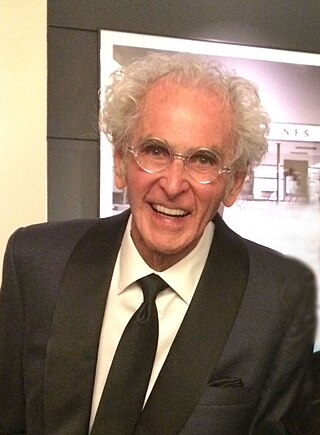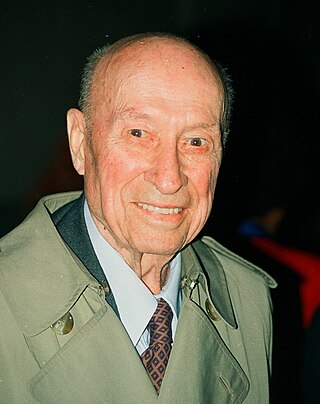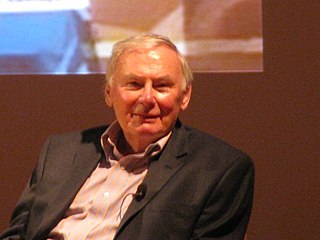Related Research Articles

Kenneth Noland was an American painter. He was one of the best-known American color field painters, although in the 1950s he was thought of as an abstract expressionist and in the early 1960s he was thought of as a minimalist painter. Noland helped establish the Washington Color School movement. In 1977, he was honored by a major retrospective at the Solomon R. Guggenheim Museum in New York that then traveled to the Hirshhorn Museum and Sculpture Garden in Washington, D.C., and Ohio's Toledo Museum of Art in 1978. In 2006, Noland's Stripe Paintings were exhibited at the Tate in London.

Lewis "Duke" Baltz was an American visual artist, photographer, and educator. He was an important figure in the New Topographics movement of the late 1970s. His best known work was monochrome photography of suburban landscapes and industrial parks which highlighted his commentary of void within the "American Dream".

Jerry Norman Uelsmann was an American photographer.

Harry Morey Callahan was an American photographer and educator. He taught at both the Institute of Design in Chicago and the Rhode Island School of Design.

Richard Estes is an American artist, best known for his photorealist paintings. The paintings generally consist of reflective, clean, and inanimate city and geometric landscapes. He is regarded as one of the founders of the international photo-realist movement of the late 1960s, with such painters as John Baeder, Chuck Close, Robert Cottingham, Audrey Flack, Ralph Goings, and Duane Hanson. Author Graham Thompson writes "One demonstration of the way photography became assimilated into the art world is the success of photorealist painting in the late 1960s and early 1970s. It is also called super-realism or hyper-realism and painters like Richard Estes, Denis Peterson, Audrey Flack, and Chuck Close often worked from photographic stills to create paintings that appeared to be photographs."
Nicholas Nixon is an American photographer, known for his work in portraiture and documentary photography, and for using the 8×10 inch view camera.

Douglas Huebler was an American conceptual artist.
Christopher Williams is an American conceptual artist and fine-art photographer. He lives in Cologne and works in Düsseldorf.
Robert Hugh Cumming was an American painter, sculptor, photographer, and printmaker best known for his photographs of conceptual drawings and constructions, which layer meanings within meanings, and reference both science and art history.
Thomas Joshua Cooper is an American photographer. He is considered among the premier contemporary landscape photographers.
Larry Sultan was an American photographer from the San Fernando Valley in California. He taught at the San Francisco Art Institute from 1978 to 1988 and at the California College of the Arts in San Francisco 1989 to 2009.
William Larson is an American photographer who has influenced the photographic world with conceptual pieces that examine the role of technology in art.
Keith A. Smith is an American artist and author. He has taught at the Visual Studies Workshop, the School of the Art Institute of Chicago, and the University of Illinois. He is a recipient of two Guggenheim Fellowships, a National Endowment of the Arts grant and a Pollock-Krasner Foundation grant. Smith creates books as works of art, as well as instructional texts on how to make books. Permanent collections which hold works by Smith include the National Gallery of Art, Museum of Modern Art, the National Gallery of Canada, and the Center for Creative Photography.
Franco A. "Frank" Barsotti was an American photographer. Youngest of three children, he was born and raised in Chicago's historic Pullman area by Italian immigrant parents. Italy, where he returned often, was a common theme through much of his work, such as the series Italy 1974 and White.
Miles Coolidge is a Canadian-American photographer and art-educator who teaches as a professor at the University of California, Irvine. Known for his focus on subjects that blur the line between architecture and landscape, Coolidge's work has also been known to engage the viewing space through its use of scale, in combination with its subject matter. His photographic projects have been exhibited internationally in numerous galleries and museums. He lives and works in Los Angeles, California.
Barbara Crane was an American artist photographer born in Chicago, Illinois. Crane worked with a variety of materials including Polaroid, gelatin silver, and platinum prints among others. She was known for her experimental and innovative work that challenges the straight photograph by incorporating sequencing, layered negatives, and repeated frames. Naomi Rosenblum notes that Crane "pioneered the use of repetition to convey the mechanical character of much of contemporary life, even in its recreational aspects."
Joyce Neimanas is an American artist known for her unorthodox approach to photography and mixed-media works.
Charles H. Traub is an American photographer and educator, known for his ironic real world witness color photography. He was chair of the photography department at Columbia College Chicago, where he established its Museum of Contemporary Photography (MOCP) in 1976, and became a director of New York's Light Gallery in 1977. Traub founded the MFA program in Photography, Video, and Related Media at the School of Visual Arts in New York City in 1987, which was the first program of its kind to fully embrace digital photographic practice. He has been Chairperson of the program since. Traub has published many books of his photographs and writings on photography and media.
Jin Lee is a photographer and educator who has exhibited throughout the United States. Her work is engaged in "the sensuous experience of a place. Her photographs are in part a highly personal investigation of the city where she lives and the surrounding natural environments."
Robert Stiegler (1938–1990) was a Chicago filmmaker and photographer, whose work grew out of the approaches to photography and design taught at the Institute of Design (ID) in the 1960s and 1970s. Stiegler received his Bachelor's degree in 1960 and his Master's degree in 1970 from ID, where he studied under Harry Callahan and Aaron Siskind and was part of a group of students that included Barbara Crane, Kenneth Josephson, Tom Rago, and Richard Nickel. His work is in the collections of the Museum of Modern Art in New York, the Art Institute of Chicago, the George Eastman House, the Museum of Contemporary Art in Chicago, and the University of Illinois Chicago. His films Traffic (1960), Capitulation (1965), Licht Spiel Nur 1 (1967), and Full Circle (1968) are housed at the Chicago Film Archives.